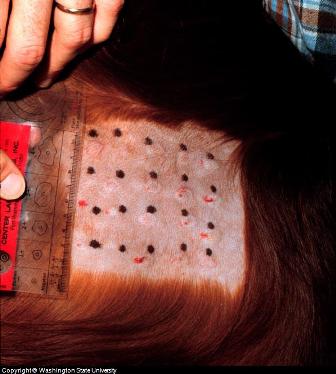Dog Allergies: Seasonal Allergies
Causes & Signs of Seasonal Allergies:
To date, a number of environmental and ecological factors have been identified as a cause for dog seasonal allergies. These include pollens, temperature (High or Low), humidity, trees and grasses. Any dog can be affected by these factors; it is suspected that it is due to the genetic makeup of the dog, irrelevant of age, breed or sex. Some dogs may get allergies, as a response to vaccination at a young age, excessive use of some steroids and some physiological complications associated with the endocrine (hormones) system.

Dog Seasonal Allergies Skin Test
Pictured: Intradermal skin testing in an Irish Setter
Source: Washington State University
Skin symptoms are the most common allergic reaction in dogs in the form of an itch. This is often accompanied by a behavioral change with a dog appearing less friendly or irritable.
Pollens; Pollen is given off by flowers, trees or grasses, usually in the later part of the summer or the fall. It may cause inhalant allergies in dogs. Pollen may trigger an immune response when pollen is inhaled, causing the allergic reaction.
Species of plants which depend upon pollination for their germination can cause allergies in dogs. These pollens contain proteins; which in error triggers self-immunity; causing an inflammatory response is seen on the skin and in the respiratory tract.
Skin problems, scratching and itching are the main signs associated with pollen allergy. Signs of allergy include alopecia (hair loss) and skin lesions. Upper respiratory tract involvement is common which includes signs such as sneezing, cough, rhinitis (runny nose) and mild tracheobronchitis.
Skin allergy (canine atopy) may start during specific seasons but in some dogs it may worsen over time to become a year round problem.
Temperature: Both hot and cold weather can cause a form of allergy in dogs. In hot weather a dog may experience skin rashes that are distributed all over the skin. This is caused by excessive sweating and seborrhea. Heat allergy is not common.
In extreme cold a dog can experience “Frost Bite Allergy”. This form involves stiffening of the body parts and sometimes in severe conditions paralysis may also occur. The Thermoregulatory system responds vigorously to cold, and as a result, secretions from the pituitary gland causes an increased immune response; which ends with a frostbite allergy.
Humidity: Prolonged or excessive humidity is associated with mold infection. It is not a true allergy but the way it happens, known as the mechanism, makes it act like an allergy. Molds are types of fungus; which grow in high humidity and initially causes an allergic reaction on the skin, which is followed by a true fungal infection on the skin.
Some molds, if ingested by dogs, will cause vomiting and
sometimes diarrhea; which is also called a mechanized form of mold
allergy.
Trees & Grasses: Pollens, parts of the tree, or
grass can cause allergies in dogs. Oak, Bermuda
grass, Johnson grass, Wild oat, Silver maple, Velvet grass, Sage Brush
and White elm are some examples of trees and grasses; which
can
cause seasonal allergies in dogs. In most cases, signs are
usually exhibited
over the skin, exposed body parts and the respiratory tract.
Diagnosis:
Clinical examinations alone are never enough to diagnose a dog seasonal allergy. History and a detailed counseling with respect to management, seasonal experiences, vaccinations and habits are usually required. The owner must be aware and be able to describe seasonal effects on his/her dog. Sometimes a seasonal skin allergy is confused with flea bite dermatitis.
A test for determining a pollen allergy can be carried out by
introducing pollens (silver maple or artificial histamines are used)
under shaved skin and studying the inflammatory response
after a few
minutes or hours. A dog can be shown to be allergic by this method.
Treatment:
A dog can only be termed as affected by a seasonal allergy if exposed to seasonal allergens at least twice. The first exposure triggers the immune system which then creates antibodies. The second exposure is when the allergic reaction which is a release of the chemical histamine. Once it is confirmed that a dog is allergic to seasonal factors, a treatment plan may be prescribed, depending upon the cause of the allergy.
Management is more important then the use of any therapeutic agent. Keeping a dog inside during the suspected seasons, days when the pollen population is higher, or when the weather is inadequate. Similarly keeping a dog away from humid environments can make a difference. Wiping down a dog with a damp towel can be helpful when a dog comes in from outdoors. A bath in cool water can also help, particularly with itch.
Other measures may include some food adjustments, such as reducing the milk, beef or wheat content in food. In many cases it is noted that food and seasonal allergies are correlated.
Use of some anti–allergic drugs, anti–histamines such as Benadryl (work in 40% of dogs - ask veterinarian for dosage for your dog ), nasal sprays and pollen repellents are available and considered to be effective. In case of skin scratching and irritation, shampoos containing cleansing agents such as Dermcare colloidal oatmeal or DermCare Anti-Itch can be helpful.
More specifically, prior to the suspected season, pollen allergy shots are considered the best way to prevent seasonal allergies. This method is a bit expensive but no complications are usually reported.
Fish oil/fatty acid supplements such as Derm Tabs can also be helpful when restoring skin condition as an addition to the diet. These types of supplements can have a calming effect on the skin.
Homeopathic remedies may also help to bring some temporary itch relief when caused by dog seasonal allergies. One product made specifically for this purpose is Allergy Itch Ease. It contains natural ingredients such as Chamomilla (soothing effect), Comocladia (helps with skin redness), Viola tri (for itch) and Arum triph (itch and redness).
|
|